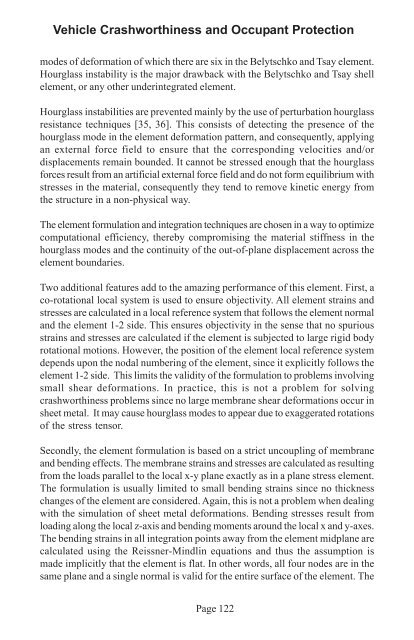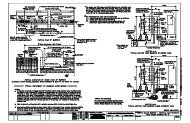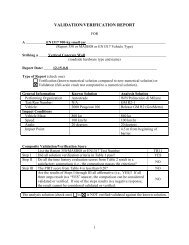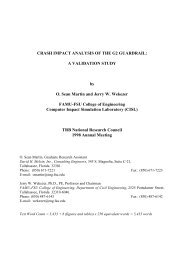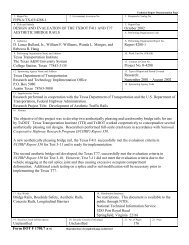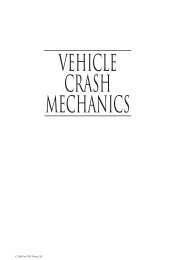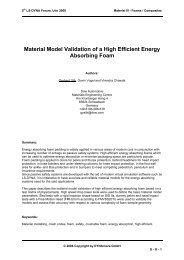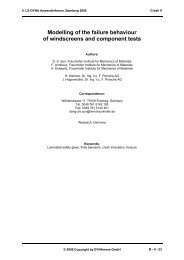Vehicle Crashworthiness and Occupant Protection - Chapter 3
Vehicle Crashworthiness and Occupant Protection - Chapter 3
Vehicle Crashworthiness and Occupant Protection - Chapter 3
You also want an ePaper? Increase the reach of your titles
YUMPU automatically turns print PDFs into web optimized ePapers that Google loves.
<strong>Vehicle</strong> <strong>Crashworthiness</strong> <strong>and</strong> <strong>Occupant</strong> <strong>Protection</strong><br />
modes of deformation of which there are six in the Belytschko <strong>and</strong> Tsay element.<br />
Hourglass instability is the major drawback with the Belytschko <strong>and</strong> Tsay shell<br />
element, or any other underintegrated element.<br />
Hourglass instabilities are prevented mainly by the use of perturbation hourglass<br />
resistance techniques [35, 36]. This consists of detecting the presence of the<br />
hourglass mode in the element deformation pattern, <strong>and</strong> consequently, applying<br />
an external force field to ensure that the corresponding velocities <strong>and</strong>/or<br />
displacements remain bounded. It cannot be stressed enough that the hourglass<br />
forces result from an artificial external force field <strong>and</strong> do not form equilibrium with<br />
stresses in the material, consequently they tend to remove kinetic energy from<br />
the structure in a non-physical way.<br />
The element formulation <strong>and</strong> integration techniques are chosen in a way to optimize<br />
computational efficiency, thereby compromising the material stiffness in the<br />
hourglass modes <strong>and</strong> the continuity of the out-of-plane displacement across the<br />
element boundaries.<br />
Two additional features add to the amazing performance of this element. First, a<br />
co-rotational local system is used to ensure objectivity. All element strains <strong>and</strong><br />
stresses are calculated in a local reference system that follows the element normal<br />
<strong>and</strong> the element 1-2 side. This ensures objectivity in the sense that no spurious<br />
strains <strong>and</strong> stresses are calculated if the element is subjected to large rigid body<br />
rotational motions. However, the position of the element local reference system<br />
depends upon the nodal numbering of the element, since it explicitly follows the<br />
element 1-2 side. This limits the validity of the formulation to problems involving<br />
small shear deformations. In practice, this is not a problem for solving<br />
crashworthiness problems since no large membrane shear deformations occur in<br />
sheet metal. It may cause hourglass modes to appear due to exaggerated rotations<br />
of the stress tensor.<br />
Secondly, the element formulation is based on a strict uncoupling of membrane<br />
<strong>and</strong> bending effects. The membrane strains <strong>and</strong> stresses are calculated as resulting<br />
from the loads parallel to the local x-y plane exactly as in a plane stress element.<br />
The formulation is usually limited to small bending strains since no thickness<br />
changes of the element are considered. Again, this is not a problem when dealing<br />
with the simulation of sheet metal deformations. Bending stresses result from<br />
loading along the local z-axis <strong>and</strong> bending moments around the local x <strong>and</strong> y-axes.<br />
The bending strains in all integration points away from the element midplane are<br />
calculated using the Reissner-Mindlin equations <strong>and</strong> thus the assumption is<br />
made implicitly that the element is flat. In other words, all four nodes are in the<br />
same plane <strong>and</strong> a single normal is valid for the entire surface of the element. The<br />
Page 122


